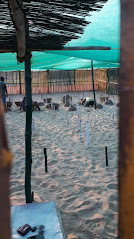Turtle Walk, Besant Nagar Beach, Chennai
On one hand, I witnessed selfless compassion in action for students at the Ramakrishna Student's Residential School in Mylapore. A couple of days later, I saw the same extended by volunteers to sea turtles on the beaches of Chennai.
Kalpana took me on a themed turtle walk led by Yuvan Aves, a teacher and expert in Marine Biology. We met at Besant Nagar beach on a Saturday afternoon. The sea breeze and waves washed away the afternoon heat and thoughts, making it a wonderful walk along the beach through the fishermen's village. We strolled in a leisurely fashion by their catamarans, looking for clues and treasures of the ocean - with child like joy when we found a special shell or foot prints, markings. We reached the turtle hatchery and waited with barely contained excitement to see the turtle hatchlings as they were dug up from their nests and gently released to crawl to the sea. It was emotional to see the tiny turtle hatchlings touch sea and swim in.
"Kadalora Kavithaigal" (the name of the 1980s movie) kept coming back to my mind, as I heard the melody of the crashing waves and the different shell patterns - poetry along the shore.
The back-story:
Turtles, around 9 species reach the shores of Madras beaches from late October. The breeding season is from late Oct to Feb. The mother turtles reach the beach, find a decent spot on the beach, dig a nest in the sands in the shape of a pot and lay 120-150 eggs, cover it up and swim back to the vast expanse of the Bay of Bengal. All along the East Coast of India from Orissa to Tamil Nadu are breeding grounds for the sea turtles.
Volunteers patrol the beach, walking many miles from the nights of late October, on the look out for the turtles. Once a mother turtle has swum back, the volunteers reach the nest, measure the height, depth and note other details of the nest. They replicate the nest in the hatchery and transfer the eggs to the nest. The hatchery is maintained by volunteers along with the Tamil Nadu Forest Department. Each nest has details, number of eggs, date they were laid etc. The eggs hatch in 45 days. The hatchlings are collected in bamboo baskets and released after sun-down. The temperature of the nests determines the gender of the hatchlings, they need to be maintained around 27.1 degrees, any more, all hatchlings will be female. The turtles live for around 70 years. After 2 years, the female hatchling, who is an adult now, will return to the same stretch of the beach to nest. The hatchlings are released at a certain distance from the waters, this walk to the waters strengthens their muscles and the GPS co-ordinates are registered during this walk to the water.
Only 1 in 1000 of these turtles will reach adulthood. The eggs and hatchlings have many predators including humans, crows, crabs and other sea-creatures. Plastics are a threat; the turtles mistake plastic bags for jelly fish and consume them with fatal consequences. Industrial size commercial shipping boats with mechanised shipping nets capture sea turtles along with fish. The nets remain submerged in water and sea-turtles who need to come to the ocean surface to breath, die in large numbers in these submerged nets.
These walks are open to general public and genuinely interested people can sign up to patrol the beaches.
More info:
The Students Sea Turtle Conservation Network [SSTCN]: https://sstcn.org/
Madras Naturalist's Society: https://www.blackbuck.org.in/about.php
Follow Yuvan: https://www.instagram.com/a_naturalists_column/


